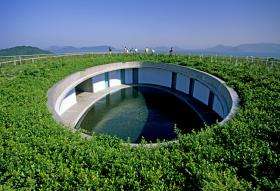Japanese architectural trends reflect unique realities, scholar says

(PhysOrg.com) -- When Japan was hit with a major economic downturn in the 1990s, it affected architectural and construction practices in Japan. Those seeking lessons applicable to related industry practices in the U.S. during the current recession won’t necessarily find exact parallels, says University of Illinois architecture professor Botond Bognar.
That’s because with certain socio-cultural considerations factored into the equation, “the Japanese case becomes a complex issue,” said Bognar, an authority on Japanese architecture and the author of the new book “Beyond the Bubble: The New Japanese Architecture” (Phaidon Press).
“Much of what happens in Japan has its own particular reasons and, therefore, is not necessarily applicable elsewhere,” Bognar said. “After the hyperactive bubble years between 1985 and 1995 - with practically unlimited investments in construction and urbanization - Japanese architects and society at large faced radically different realities, and the need to reorganize their priorities,” Bognar said.
Prior to the burst of the economic bubble - a period characterized by the U. of I. architecture professor as “the age of accelerated urbanism and architecture in the fast lane” - Japanese architects took it for granted that the buildings they designed didn’t have a long shelf life.
It was not uncommon for buildings - even landmark structures designed by well-known, well-respected architects - to be torn down after 10 or 20 years, and sometimes just a few years following completion. In their place, new buildings were routinely constructed, Bognar said.
Bognar attributes this practice to several factors, from skyrocketing land prices and an economy in overdrive to excessive consumer wealth and the commodification of private and public structures. Building, razing and rebuilding were regarded simply as engines of a functioning economy.
“Building was much more the result of contemporary economic and political forces than at any time before,” Bognar said. “It also much related to the GNP insofar as the construction industry contributed around 18 percent to it at that time,” he added, noting that the rate has been falling since the bubble burst.
During the earlier period, “there was the belief that you have to rebuild - it’s not the end product that’s important, but rather the activity of building.”
Bognar said the practice of razing and building slowed down somewhat after the bubble burst, but it continues in Japan today. As anecdotal evidence that it hasn’t disappeared completely, Bognar described what happened when he took a group of U. of I. students to Japan last spring.
“I was scheduled to take students to see the Kirin Plaza in Osaka and the Syntax Building in Kyoto, two notable examples of contemporary Japanese architecture. They were completed as recently as 1987 and 1990, respectively, from the designs of internationally acclaimed architect Shin Takamatsu.
“But when we got to the Kirin Plaza, it was being demolished. And at the Syntax, no building; it was already gone.”
Bognar noted that within the context of traditional culture, architecture in Japan has long been regarded as “part of the natural forces,” meaning that the ritual rebuilding of Shinto shrines and other edifices on a regular basis reflected beliefs about the cyclical renewal of nature.
“Modern-day architectural practices thus appear to parallel these ancient customs that were derivative of the philosophy ‘all things must pass.’ ” Even so, he noted, “no one should assume that any of today’s extensive changes in the built environment are truly related to ancient rituals or customs; these developments are indeed the result of powerful economic forces, political interests and contemporary lifestyles.”
A more tangible characteristic that post-bubble Japan shares in common with the current recession-restrained U.S. architectural landscape is that “much less is built in Japan today.”
“With huge investments in building (during the bubble years), there was an abundance of large-scale and significant projects - such as the Kirin Plaza - regarded as ‘cultural buildings.’ And well-to-do companies built ‘PR buildings,’ with theaters, exhibition galleries, restaurants. The late 1980s-early 1990s also were the times when such architects as Tadao Ando, Fumihiko Maki, Itsuko Hasegawa, Toyo Ito and others reached the epitome of their creativity and turned out numerous pieces of truly world-class architecture. Perhaps not paradoxically, this was also the ‘golden age of Japanese architecture and design.’ ”
Another architectural trend in Japan during the post-bubble years and one gaining ground rapidly in the United States is a keen interest in sustainability. In Japan, the reasons for embracing so-called “green” building practices weren’t entirely driven by the economy. Just as today’s U.S. interest in green building is fueled by potential future monetary savings and an interest in reducing carbon emissions, Japan’s movement toward increased sustainability was complex and multifaceted. Again, cultural issues played a role.
Architects increasingly place an emphasis on “how to engage nature as an aesthetic and a means to provide eco-friendly architecture,” Bognar said. “Companies such as Nikken Sekkei Ltd. have a long history of emphasizing sustainable practices, but after the burst of the bubble, they become much more active in this area.”
“The result is often a return to traditional materials, or finding new ways of using traditional materials such as wood, paper, bamboo and dry reeds,” he said.
“They also have begun using new materials that are the product of advanced technologies - new types of glass, alloys, synthetic fibers and fabric, heat insulation.” Other changes emphasizing energy savings and sustainability include designing buildings that are partially, or when possible, fully underground, or with landscaped and green rooftops.
“There also is a continued movement to discover the simple,” he said.
“ ‘Less is more’ is coming to the forefront in Japan. There is now a growing interest in what I would call ‘earthly,’ or down-to-earth innovation - in the poetics of the ordinary. The framework has become how to provide quality architecture with limited means.”
And that is a lesson that post-U.S.-bubble architects, builders and consumers of their designs can take to the bank.
Provided by University of Illinois at Urbana-Champaign















